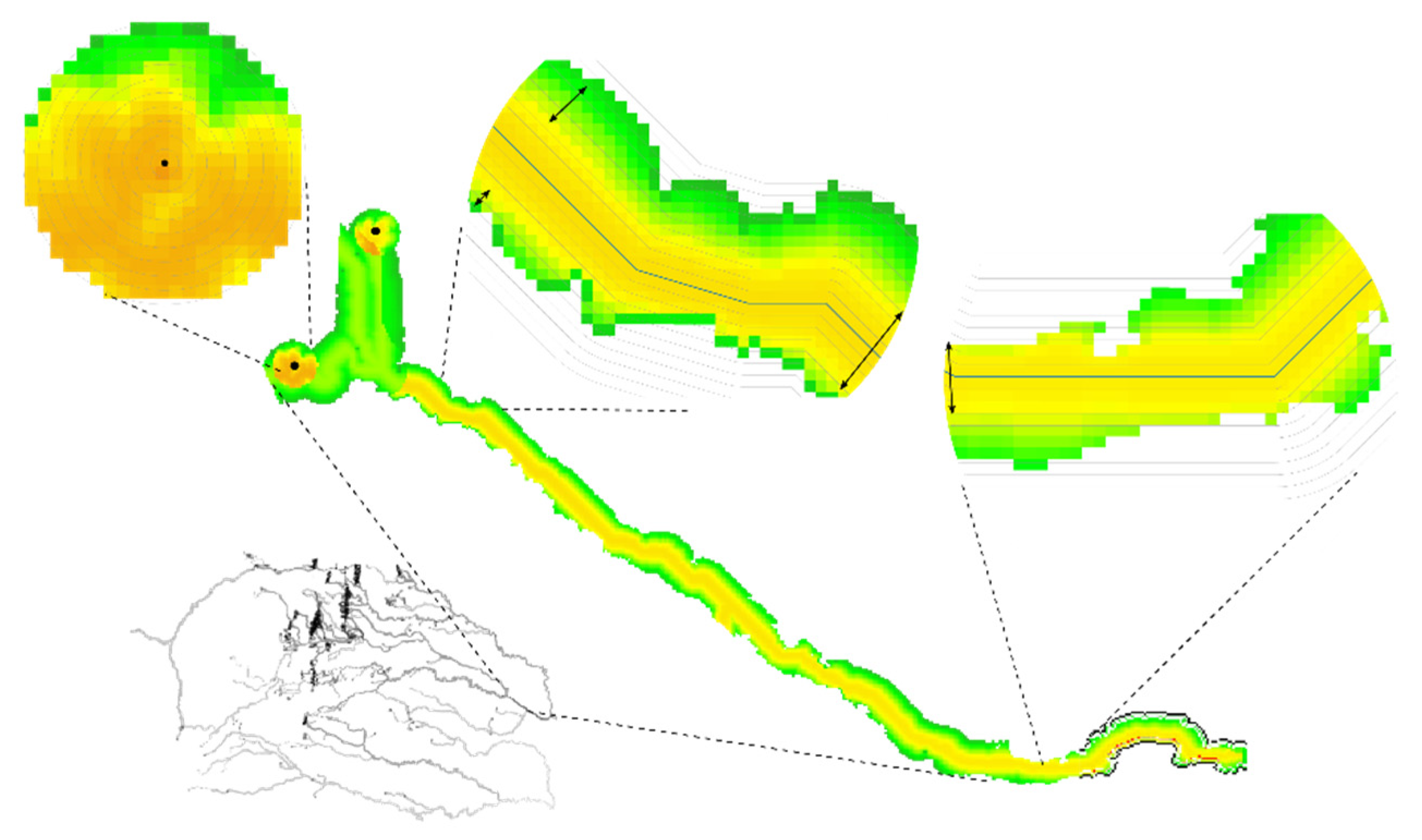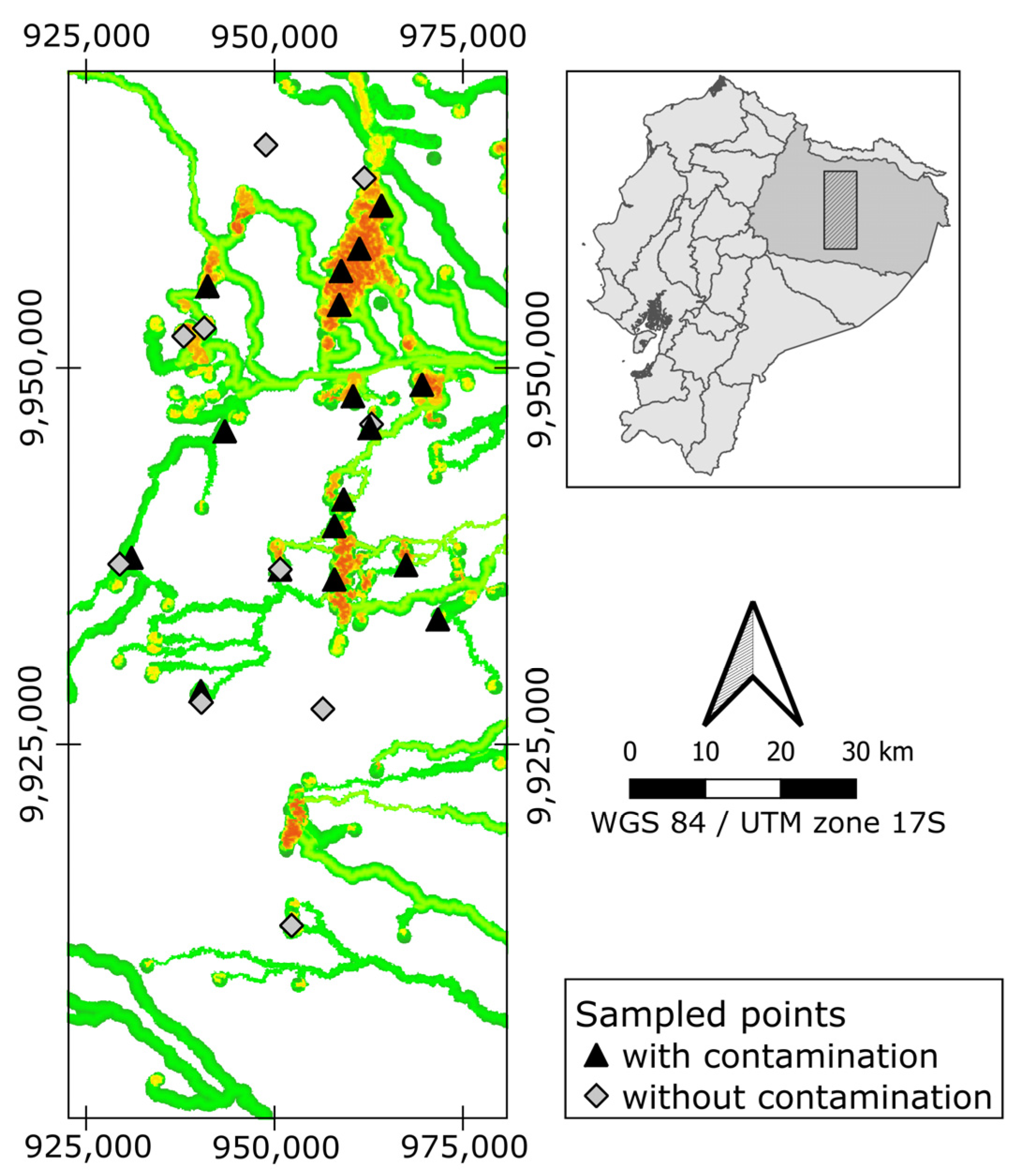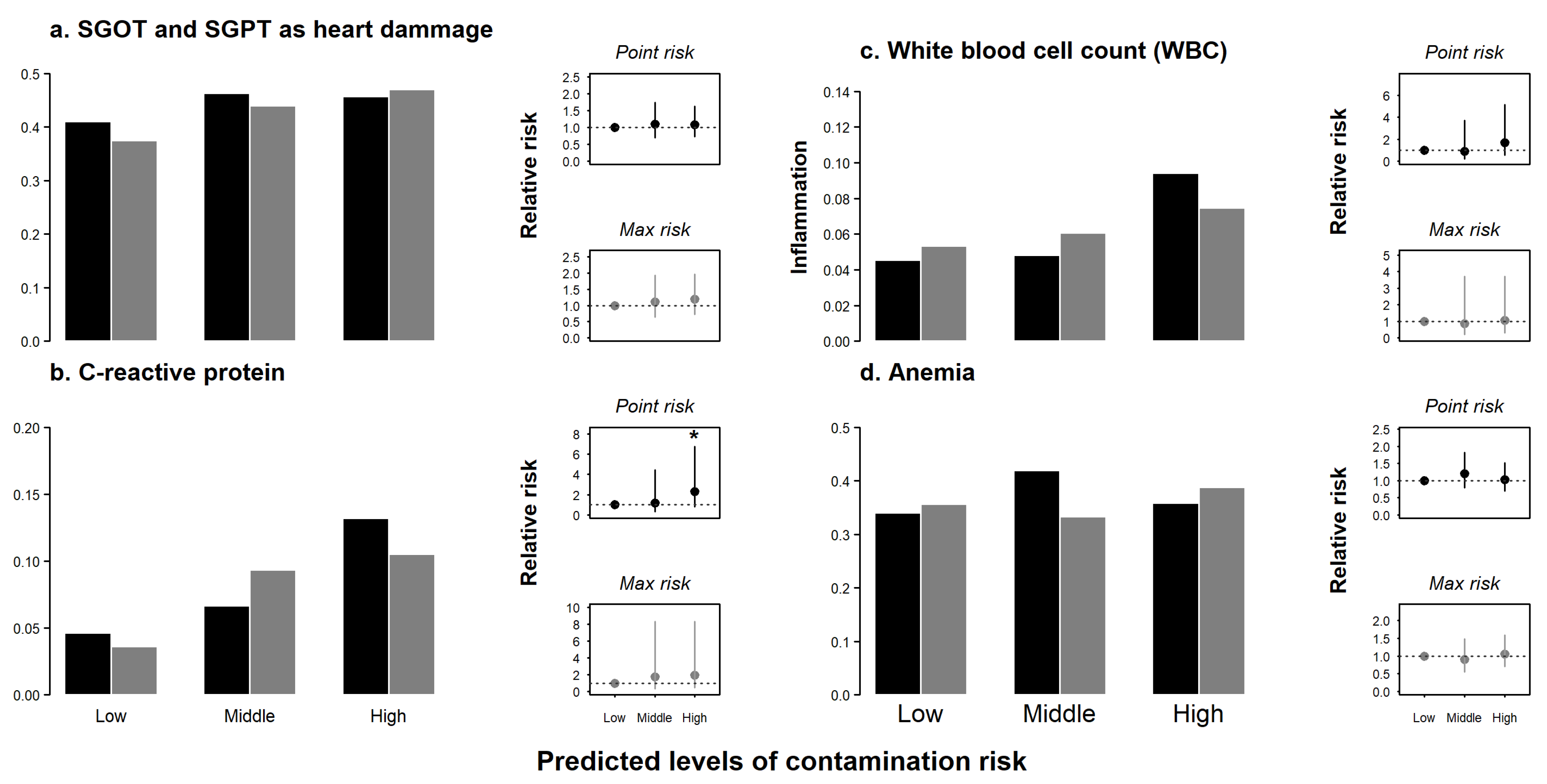Vulnerability of Human Populations to Contamination from Petroleum Exploitation in the Napo River Basin: An Approach for Spatially Explicit Risk Assessment
Abstract
:1. Introduction
2. Materials and Methods
2.1. Study Area
2.2. Model Overview
2.2.1. Calculation of the Friction Surface
2.2.2. Analysis of Accessibility
2.2.3. Potential for Contamination
2.3. Model Validation
2.4. Vulnerability of Human Populations and Human Health
3. Results
3.1. Spatial Model of Contamination Risk and Model Validation
3.2. Vulnerability of Land and People
4. Discussion
5. Conclusions
Author Contributions
Funding
Institutional Review Board Statement
Informed Consent Statement
Data Availability Statement
Acknowledgments
Conflicts of Interest
References
- Bryan, G.W.; Langston, W.J. Bioavailability, accumulation and effects of heavy metals in sediments with special reference to United Kingdom estuaries: A review. Environ. Pollut. 1992, 76, 89–131. [Google Scholar] [CrossRef]
- Norwood, W.P.; Borgmann, U.; Dixon, D.G.; Wallace, A. Effects of metal mixtures on aquatic biota: A review of observations and methods. Hum. Ecol. Risk Assess. 2003, 9, 795–811. [Google Scholar] [CrossRef]
- Sakan, S.M.; Dordević, D.S.; Manojlović, D.D.; Predrag, P.S. Assessment of heavy metal pollutants accumulation in the Tisza river sediments. J. Environ. Manag. 2009, 90, 3382–3390. [Google Scholar] [CrossRef]
- Kumar, A.; Pinto, M.C.; Candeias, C.; Dinis, P.A. Baseline maps of potentially toxic elements in the soils of Garhwal Himalayas, India: Assessment of their eco-environmental and human health risks. L. Degrad. Dev. 2021. [Google Scholar] [CrossRef]
- Korre, A.; Durucan, S.; Koutroumani, A. Quantitative-spatial assessment of the risks associated with high Pb loads in soils around Lavrio, Greece. Appl. Geochem. 2002, 17, 1029–1045. [Google Scholar] [CrossRef]
- Carlon, C.; Pizzol, L.; Critto, A.; Marcomini, A. A spatial risk assessment methodology to support the remediation of contaminated land. Environ. Int. 2008, 34, 397–411. [Google Scholar] [CrossRef]
- Kumar, A.; Jigyasu, D.K.; Kumar, A.; Subrahmanyam, G.; Mondal, R.; Shabnam, A.A.; Cabral-Pinto, M.M.S.; Malyan, S.K.; Chaturvedi, A.K.; Gupta, D.K.; et al. Nickel in terrestrial biota: Comprehensive review on contamination, toxicity, tolerance and its remediation approaches. Chemosphere 2021, 275, 129996. [Google Scholar] [CrossRef]
- Cabral Pinto, M.M.S.; Marinho-Reis, A.P.; Almeida, A.; Freitas, S.; Simões, M.R.; Diniz, M.L.; Pinto, E.; Ramos, P.; Ferreira da Silva, E.; Moreira, P.I. Fingernail Trace Element Content in Environmentally Exposed Individuals and Its Influence on Their Cognitive Status in Ageing. Expo. Heal. 2019, 11, 181–194. [Google Scholar] [CrossRef]
- Bashir, I.; Lone, F.A.; Bhat, R.A.; Mir, S.A.; Dar, Z.A.; Dar, S.A. Concerns and threats of contamination on aquatic ecosystems. Bioremediation Biotechnol. Sustain. Approaches Pollut. Degrad. 2020, 1–26. [Google Scholar] [CrossRef] [Green Version]
- Norse, E.A.; Amos, J. Impacts, Perception, and Policy Implications of the Deepwater Horizon Oil and Gas Disaster. Law Rep. 2010, 40, 11058–11073. [Google Scholar]
- Goldman, R.; Biton, E.; Brokovich, E.; Kark, S.; Levin, N. Oil spill contamination probability in the southeastern Levantine basin. Mar. Pollut. Bull. 2015, 91, 347–356. [Google Scholar] [CrossRef] [Green Version]
- Muñoz, F.; Barriga, R.; Vera, E. Identificación de hidrocarburos aromáticos policíclicos (HAP’s) en peces y sedimentos en la zona de Shushufindi, Sucumbios, Ecuador. Rev. Politec. 2010, 29, 143–149. [Google Scholar]
- Liang, Y.; Zhang, X.; Wang, J.; Li, G. Spatial variations of hydrocarbon contamination and soil properties in oil exploring fields across China. J. Hazard. Mater. 2012, 241–242, 371–378. [Google Scholar] [CrossRef]
- Li, J.; Dong, H.; Zhang, D.; Han, B.; Zhu, C.; Liu, S.; Liu, X.; Ma, Q.; Li, X. Sources and ecological risk assessment of PAHs in surface sediments from Bohai Sea and northern part of the Yellow Sea, China. Mar. Pollut. Bull. 2015, 96, 485–490. [Google Scholar] [CrossRef]
- Wang, Y.-B.; Liu, C.-W.; Kao, Y.-H.; Jang, C.-S. Characterization and risk assessment of PAH-contaminated river sediment by using advanced multivariate methods. Sci. Total Environ. 2015, 524–525, 63–73. [Google Scholar] [CrossRef]
- Xu, L.; Wang, T.; Ni, K.; Liu, S.; Wang, P.; Xie, S.; Meng, J.; Zheng, X.; Lu, Y. Ecological Risk Assessment of Arsenic and Metals in Surface Sediments from Estuarine and Coastal Areas of the Southern Bohai Sea, China. Hum. Ecol. Risk Assess. An Int. J. 2014, 20, 388–401. [Google Scholar] [CrossRef] [Green Version]
- Liu, F.; Liu, J.L.; Chen, Q.Y.; Wang, B.B.; Cao, Z.G. Pollution characteristics and ecological risk of polycyclic aromatic hydrocarbons (PAHs) in surface sediments of the southern part of the Haihe River system in China. Chin. Sci. Bull. 2013, 58, 3348–3356. [Google Scholar] [CrossRef] [Green Version]
- Christensen, E.R.; Li, A.; Ab Razak, I.A.; Rachdawong, P.; Karls, J.F. Sources of polycyclic aromatic hydrocarbons in sediments of the Kinnickinnic River, Wisconsin. J. Great Lakes Res. 1997, 23, 61–73. [Google Scholar] [CrossRef]
- Ingersoll, C.G.; MacDonald, D.D.; Wang, N.; Crane, J.L.; Field, L.J.; Haverland, P.S.; Kemble, N.E.; Lindskoog, R.A.; Severn, C.; Smorong, D.E. Predictions of sediment toxicity using consensus-based freshwater sediment quality guidelines. Arch. Environ. Contam. Toxicol. 2001, 41, 8–21. [Google Scholar] [CrossRef]
- San Sebastián, M.; Armstrong, B.; Stephens, C. The health of women who live near oil wells and oil production stations in the Amazon region of Ecuador. Rev. Panam. Salud Publica/Pan Am. J. Public Health 2001, 9, 375–384. [Google Scholar] [CrossRef] [Green Version]
- Kim, K.H.; Jahan, S.A.; Kabir, E.; Brown, R.J.C. A review of airborne polycyclic aromatic hydrocarbons (PAHs) and their human health effects. Environ. Int. 2013, 60, 71–80. [Google Scholar] [CrossRef] [PubMed]
- Sebastian, S. Oil Development and Health in the Amazon Basin of Ecuador: The Popular Epidemiology Process. Available online: https://pubmed.ncbi.nlm.nih.gov/15571897/ (accessed on 1 July 2021).
- Salerno, C.; Berchialla, P.; Palin, L.A.; Vanhaecht, K.; Panella, M. Cancer morbidity of residents living near an oil refinery plant in North-West Italy. Int. J. Environ. Health Res. 2013, 23, 342–351. [Google Scholar] [CrossRef] [PubMed]
- Bertazzi, P.A.; Pesatori, A.C.; Zocchetti, C.; Latocca, R. Mortality study of cancer risk among oil refinery workers. Int. Arch. Occup. Environ. Health 1989, 61, 261–270. [Google Scholar] [CrossRef] [PubMed]
- Sorahan, T. Mortality of UK oil refinery and petroleum distribution workers, 1951–2003. Occup. Med. 2007, 57, 177–185. [Google Scholar] [CrossRef] [Green Version]
- Semple, K.T.; Morriss, A.W.J.; Paton, G.I. Bioavailability of hydrophobic organic contaminants in soils: Fundamental concepts and techniques for analysis. Eur. J. Soil Sci. 2003, 54, 809–818. [Google Scholar] [CrossRef]
- Arnot, J.A.; Gobas, F.A.P.C. A food web bioaccumulation model for organic chemicals in aquatic ecosystems. Environ. Toxicol. Chem. 2004, 23, 2343–2355. [Google Scholar] [CrossRef] [Green Version]
- Gassiat, C.; Gleeson, T.; Lefebvre, R.; McKenzie, J. Hydraulic fracturing in faulted sedimentary basins: Numerical simulation of potential contamination of shallow aquifers over long time scales. Water Resour. Res. 2013, 49, 8310–8327. [Google Scholar] [CrossRef] [Green Version]
- Mayer, B.; Humez, P.; Becker, V.; Nightingale, M.; Ing, J.; Kingston, A.; Clarkson, C.; Cahill, A.; Parker, E.; Cherry, J.; et al. Prospects and Limitations of Chemical and Isotopic Groundwater Monitoring to Assess the Potential Environmental Impacts of Unconventional Oil and Gas Development. Procedia Earth Planet. Sci. 2015, 13, 320–323. [Google Scholar] [CrossRef] [Green Version]
- Besser, H.; Hamed, Y. Causes and risk evaluation of oil and brine contamination in the Lower Cretaceous Continental Intercalaire aquifer in the Kebili region of southern Tunisia using chemical fingerprinting techniques. Environ. Pollut. 2019, 253, 412–423. [Google Scholar] [CrossRef]
- Lahr, J.; Kooistra, L. Environmental risk mapping of pollutants: State of the art and communication aspects. Sci. Total Environ. 2010, 408, 3899–3907. [Google Scholar] [CrossRef]
- Machado, D. Desarrollo de un SIG en plataforma Arc-Info, para Modelar Espacialmente Derrames de Petróleo en Tierra. Caso de estudio: Campos Petroleros de la Región Oriental de Venezuela. In Proceedings of the VI Conferencia Latinoamericana de usuarios ARC/INFO y ERDAS, Caracas, Venezuela, 12–16 April 1999; Available online: https://proceedings.esri.com/library/userconf/latinproc99/ponencias/ponencia21.html (accessed on 1 August 2021).
- Maroko, A.R. Using air dispersion modeling and proximity analysis to assess chronic exposure to fine particulate matter and environmental justice in New York City. Appl. Geogr. 2012, 34, 533–547. [Google Scholar] [CrossRef]
- Omo-Irabor, O.O.; Olobaniyi, S.B. Application of Multi-criteria Decision Analysis and GIS Techniques in Vulnerability Assessment of Coastal Inhabitants in Nigeria to Crude Oil Production and Transportation Activities. In Spatial Enablement in Support of of Economic Development and Poverty Reduction; Onsrud, H., Rajabifard, A., Eds.; GSDI Association Press: Needham, MA, USA, 2013; pp. 169–190. [Google Scholar]
- Zurita-Arthos, L.; Mulligan, M. Multi-criteria GIS analysis and geo-visualisation of the overlap of oil impacts and ecosystem services in the Western Amazon. Int. J. Geoinform. 2013, 9, 45–52. [Google Scholar]
- French-McCay, D. Modeling as a Scientific Tool in NRDA for Oil and Chemical Spills. Int. Oil Spill Conf. 2008, 53, 160. [Google Scholar] [CrossRef]
- Jones, R.; Barron, M. Site Selection of Petroleum Pipelines: A GIS Approach to Minimize Environmental Impacts and Liabilities. Available online: https://proceedings.esri.com/library/userconf/proc99/proceed/papers/pap350/p350.htm (accessed on 1 August 2021).
- Rahman, A.; Lownes, N. Risk Assessment of Hazardous Material Transportation Routes in the City of New Haven. Available online: https://citeseerx.ist.psu.edu/viewdoc/download?doi=10.1.1.965.6642&rep=rep1&type=pdf (accessed on 1 August 2021).
- Miller, J.; Onwuetaka, J. Using GIS to Model Environmental Vulnerability in Coastal Oil Fields, East Central Nigeria. In Proceedings of the ESRI Proceedings, 1999; Available online: https://proceedings.esri.com/library/userconf/proc99/proceed/papers/pap460/p460.htm (accessed on 1 August 2021).
- Udoh, J.; Ekanem, E. GIS based risk assessment of oil spill in the coastal areas of Akwa Ibom State, Nigeria. Afr. J. Environ. Sci. 2011, 5, 205–211. [Google Scholar]
- Mohamadi, B.; Xie, Z.; Liu, F. GIS based oil spill risk assessment model for the Niger Delta’s vegetation. Nat. Environ. Pollut. Technol. 2015, 14, 545–552. [Google Scholar]
- INEC Censo Nacional de Población y Vivienda del Ecuador 2010. Available online: https://www.ecuadorencifras.gob.ec/institucional/home/ (accessed on 1 August 2021).
- Análisis de Vulnerabilidad a la Contaminación de una Sección de los Acuíferos del Valle Central de Costa Rica; Esri. Available online: https://proceedings.esri.com/library/userconf/latinproc00/costa_rica/analisis_vulnerabilidad/vulnerabilidad_acuiferoscr.htm (accessed on 1 August 2021).
- IGM. WCS Service of Digital Elevation Model. 2014. Available online: http://www.geoportaligm.gob.ec/portal/ (accessed on 1 August 2021).
- Rázuri, L. Estructura de conservación de suelos y aguas. In Serie Riesgo y Drenaje, 32; Centro Interamericano de Desarrollo de Agua y Tierras: Mérida, Mexico, 1982; pp. 7–33. [Google Scholar]
- QGIS Development Team QGIS Geographic Information System 2021. Available online: https://www.qgis.org/es/site/ (accessed on 1 August 2021).
- R Development Core Team. R Core Team R: A Language and Environment for Statistical Computing. 2020. Available online: https://www.gbif.org/tool/81287/r-a-language-and-environment-for-statistical-computing (accessed on 1 August 2021).
- Kabat, G.C.; Kim, M.Y.; Manson, J.A.E.; Lessin, L.; Lin, J.; Wassertheil-Smoller, S.; Rohan, T.E. White Blood Cell Count and Total and Cause-Specific Mortality in the Women’s Health Initiative. Am. J. Epidemiol. 2017, 186, 63–72. [Google Scholar] [CrossRef] [PubMed]
- Aragon, T.J. Epitools: Epidemiology Tools 2020. Available online: https://www.r-project.org/ (accessed on 1 August 2021).
- Setiawan, A.; Yin, L.; Auer, G.; Czene, K.; Smedby, K.E.; Pawitan, Y. Patterns of acute inflammatory symptoms prior to cancer diagnosis. Sci. Rep. 2017, 7, 1–5. [Google Scholar] [CrossRef] [PubMed]
- Greten, F.R.; Grivennikov, S.I. Inflammation and Cancer: Triggers, Mechanisms, and Consequences. Immunity 2019, 51, 27–41. [Google Scholar] [CrossRef]
- Shrotriya, S.; Walsh, D.; Nowacki, A.S.; Lorton, C.; Aktas, A.; Hullihen, B.; Benanni-Baiti, N.; Hauser, K.; Ayvaz, S.; Estfan, B. Serum c-reactive protein is an important and powerful prognostic biomarker in most adult solid tumors. PLoS ONE 2018, 13, e0202555. [Google Scholar] [CrossRef]





| Slope (%) | Weight |
|---|---|
| 0–2 | 1 |
| 2–6 | 2 |
| 6–12 | 6 |
| 12–18 | 8 |
| >18 | 10 |
Publisher’s Note: MDPI stays neutral with regard to jurisdictional claims in published maps and institutional affiliations. |
© 2021 by the authors. Licensee MDPI, Basel, Switzerland. This article is an open access article distributed under the terms and conditions of the Creative Commons Attribution (CC BY) license (https://creativecommons.org/licenses/by/4.0/).
Share and Cite
Espinosa, C.I.; Reyes-Bueno, F.; Ramírez, M.I.; Arévalo, A.P.; Bailon-Moscoso, N.; Duncan, D.H. Vulnerability of Human Populations to Contamination from Petroleum Exploitation in the Napo River Basin: An Approach for Spatially Explicit Risk Assessment. Sustainability 2021, 13, 9230. https://doi.org/10.3390/su13169230
Espinosa CI, Reyes-Bueno F, Ramírez MI, Arévalo AP, Bailon-Moscoso N, Duncan DH. Vulnerability of Human Populations to Contamination from Petroleum Exploitation in the Napo River Basin: An Approach for Spatially Explicit Risk Assessment. Sustainability. 2021; 13(16):9230. https://doi.org/10.3390/su13169230
Chicago/Turabian StyleEspinosa, Carlos Iván, Fabián Reyes-Bueno, María Isabel Ramírez, Ana Paulina Arévalo, Natalia Bailon-Moscoso, and David H. Duncan. 2021. "Vulnerability of Human Populations to Contamination from Petroleum Exploitation in the Napo River Basin: An Approach for Spatially Explicit Risk Assessment" Sustainability 13, no. 16: 9230. https://doi.org/10.3390/su13169230
APA StyleEspinosa, C. I., Reyes-Bueno, F., Ramírez, M. I., Arévalo, A. P., Bailon-Moscoso, N., & Duncan, D. H. (2021). Vulnerability of Human Populations to Contamination from Petroleum Exploitation in the Napo River Basin: An Approach for Spatially Explicit Risk Assessment. Sustainability, 13(16), 9230. https://doi.org/10.3390/su13169230






